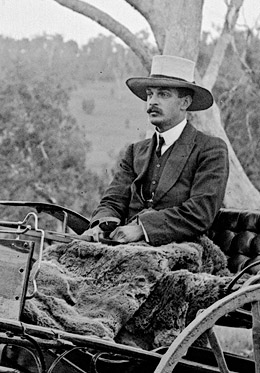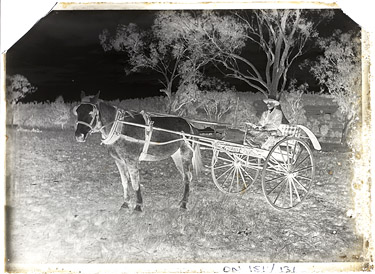Rex Hazlewood: suburban panoramas
David ‘Rex’ Hazlewood (1886 – 1968) was born in Dulwich Hill in Sydney’s Inner West and grew up in the suburban areas around Homebush, Chatswood and Epping. He first trained as a tailor in a city clothing warehouse, but in 1909 when he was 23, he began training for the Baptist ministry. Rex Hazlewood’s father, David, was a keen amateur photographer and fostered the same passion in his son. Rex spent two years in country New South Wales as student pastor and took numerous photographs of the areas around Yeoval, Manildra and Molong, where he was based. On his return to Sydney in 1911, he took many photographs of the areas around his family home in Epping – including several series of the new developments in the north western suburbs, government works and the newly-built Central Markets (now Paddy’s Markets) in the city. His photographs recall the farming days of Sydney’s outer suburbs, including fruit-growing in Epping and timber-hauling in Carlingford. Some time between 1911 and 1916, Rex Hazlewood began to identify himself as a professional photographer and he appears to have gained several contracts to record the progress of large government building projects. He enlisted in the Australian Imperial Force in 1916 and left for England in 1917. He served at the Western Front, and at the end of 1918 he was appointed an official war photographer until his return to Australia in November 1919.
After his marriage to Robin Kendall in 1920 and the birth of his son, Rex Hazlewood continued to take photographs, probably on a contract basis and for commercial postcards. Some of these postcards were taken with his rotating panoramic camera – 75 examples of panoramic negatives are held in the Mitchell Library’s collection.
> View a selection of suburban panoramas taken by Rex Hazlewood between 1921 and 1925
By the late 1920s, Rex was finding it impossible to make photography profitable as a freelance photographer. His brothers owned a nursery in Epping, and Rex worked for them, taking photographs of gardens, plants and animals to illustrate their catalogues and writing articles on plants and garden design. He developed a passion for landscape design and delivered illustrated talks on the topic to interested groups. Rex Hazlewood left his brothers’ nursery in around 1935 and undertook various jobs until the end of the Second World War, when he began a business selling wholesale roses to nurseries. His last series of photographs recorded a European trip he took with his wife in 1956-57.
Portrait of Rex Hazlewood, ca. 1910, by Rex Hazlewood
Glass photonegative ON 151 / 131
The panoramas held by the Library are nitrate negatives. Nitrate negatives are highly flammable and, with age, the negatives can produce a flammable gas which has been known to spontaneously combust. These Hazlewood negatives have been scanned and digital preservation copies have been made by the Library to replace the original unstable negatives. The photograph above is a glass plate negative - a medium also used by Hazlewood. In contrast to nitrate negatives, glass plates are very stable and safe to store.


